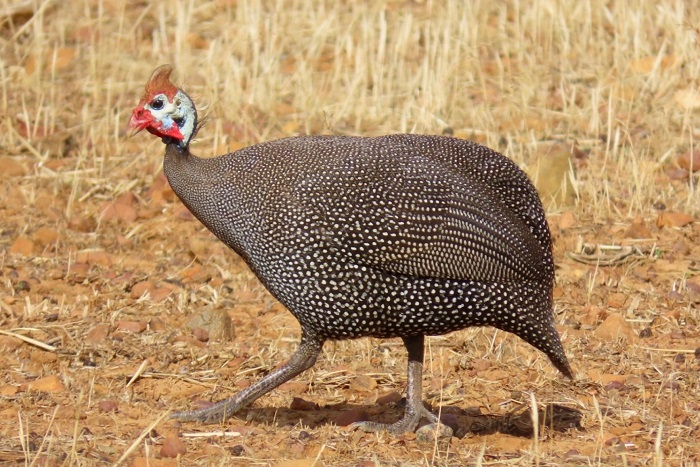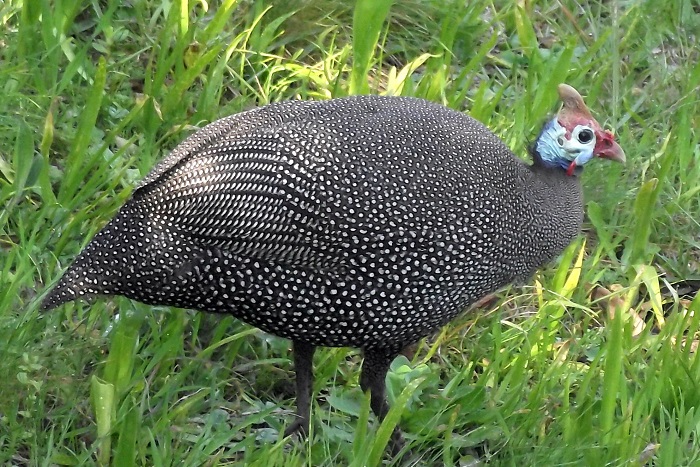Cover image by Colin Summersgill – Bisley Valley Nature Reserve, KwaZulu-Natal – BirdPix No. 248466
Identification
Guineafowl are quintessentially African birds, easy to identify and familiar to many.
The Helmeted Guineafowl is a distinctive and easily recognisable species. It has an unusual body-shape which is laterally compressed with a disproportionately small head. Adults have a large, horn-like, bony casque or ‘helmet’ on the head, and long, pendulous blue wattles with red tips on the sides of the face.

Thabazimbi district, Limpopo
Photo by Neels Putter
The base of the casque is surrounded by bare red skin extending to the cere and hind crown. The rest of the head and upper neck is powder-blue and un-feathered. The entire plumage on the body is black, with dense white spotting. The bill is horn-grey, the eyes are brown and the legs and feet are dark brown to blackish.
The sexes are alike in plumage colouration, but differ in that males have a larger casque. Juveniles have browner bodies with a reduced casque and the upper neck and throat are feathered.

Near Elandsfontein, Western Cape
Photo by Cobus Elstadt
Distribution and Status
The Helmeted Guineafowl is locally common to abundant throughout its range. It is probably Africa’s most widespread and well-known gamebird, occurring virtually throughout sub-Saharan Africa. It is found across most of southern Africa and the only extensive areas where it is absent are in some of the arid and semi-arid regions of southern Namibia, south-western Botswana and parts of the Northern Cape province. In these areas it is probably limited by the availability of drinking water and safe elevated roosts.

The Helmeted Guineafowl is particularly common in savannas interspersed with agricultural fields. Habitat modification due to cultivation, has dramatically increased its range. The Helmeted Guineafowl has become commensal with humans and now inhabits most agricultural regions as well as suburban parks and gardens.
The range of the Helmeted Guineafowl increased dramatically during the 20th century. The reasons are likely a combination of natural expansions, translocations, increased artificial water points in dry regions, and the availability of telephone poles in treeless areas for roosting on. Prior to this the Helmeted Guineafowl was not found south of the Orange River or west of Graaf-Reinet.

Addo Elephant National Park, Eastern Cape
Photo by Sybrand Venter
The species has, however, undergone dramatic local extinctions in Lesotho and parts of the eastern Cape due to heavy hunting pressure from humans and domestic predators, as well as from severe habitat degradation. An additional treat to the Helmeted Guineafowl is the introduction of domesticated guineafowl from West Africa, which could lead to wild populations becoming less viable in the future.
Habitat
The Helmeted Guineafowl’s natural habitat includes grassland and savannas, particularly along rivers and around wetlands, but occupies most open-country terrain, from semi-desert to the base of high mountains, forest edges, thicket and fynbos.

Mapungubwe National Park, Limpopo
Photo by Neels Putter
Behaviour
Adults occur in pairs or small groups during the breeding season and in small to large flocks during the remainder of the year. The Helmeted Guineafowl is mostly resident but the formation of large non-breeding flocks throughout its range implies some degree of seasonal movement.

Riverside, Mosiphane, Limpopo
Photo by Dewald du Plessis
They are reluctant to fly and only take flight if alarmed or to reach the roost. Helmeted Guineafowl roost in trees, and on telephone poles in arid, treeless areas. Some roost sites are used continuously for many years. Flocks descend from the roost at first light, before heading to drinking water. During the hottest part of the day, flocks move into thick vegetation or dense grass where they remain until it cools down in the late afternoon. Flocks drink mostly in the early morning and late afternoon. They return to the roost site just before sunset.

Mkhuze Game Reserve, KwaZulu-Natal
Photo by Len de Beer
Forages by scratching or digging at the soil surface or leaf litter with its feet, in much the same way a chicken would. Helmeted Guineafowl are omnivorous, feeding on a wide range of insects (including pest species) and other invertebrates, as well as seeds, grain, bulbs, weeds, tubers and berries. They are largely vegetarian during the non-breeding season but as the breeding season approaches their diet shifts to invertebrates, especially grasshoppers, termites and other insects. Helmeted Guineafowl also consume large numbers of ticks and are very effective in helping to control tick numbers.

iMfolozi-Hluhluwe Game Reserve, KwaZulu-Natal
Photo by Ryan Tippett
Before the onset of the breeding season flock sizes begin to decreases steadily as pairs split away from the flock. The urge to pair-up is stimulated by the first heavy rains.

Kruger National Park, Limpopo
Photo by Lia Steen
Helmeted Guineafowl are monogamous once a mate has been chosen. Evidence shows that pairs can remain together for as long as 4 years. Males are alert and will defend their mate aggressively. Males lose around 15% of their body weight through the early stages of the breeding season as they spend far less time feeding themselves, rather engaging in courtship-feeding where they catch and drop food in front of the female, while giving a Humpback display and courting call. Females on the other hand increase in weight as they spend most of their time feeding and preening.

Near Wartburg, KwaZulu-Natal
Photo by Malcolm Robinson
The female selects a suitable nest site site, most often in tall grass or under a bush, typically in thick bush near the edge of open areas. The nest is well hidden and is a simple scrape in the ground, thinly lined with feathers and grass stems. The female adds additional material during incubation.
The laying dates of the Helmeted Guineafowl vary from region to region. Eggs are laid from January to March in Namibia, Botswana and Zimbabwe, and from October to March in Eastern South Africa. In the winter-rainfall regions of the Western and Eastern Cape, most egg-laying takes place from September to December to take advantage of food abundance following the winter rains.

National Botanical Gardens, Gauteng
Photo by Dieter Oschadleus
6 to 12 eggs are laid per clutch. The eggs are pale brown to white with speckles and are among the thickest-shelled of all eggs relative to size. This is thought to provide some protection from veld fires and predation by small carnivores. Incubation starts only once the full clutch has been laid and the incubation period lasts up to 27 days. All incubation is performed by the female. She leaves the nest to forage only for short periods during day. Males abandon the females during incubation and begin to associate and mate with unpaired females. Males usually return to the female and young soon after hatching. The males then become very involved in parental care, guiding chicks to food during the day and brooding them at night. The females spend this time regaining their condition. Although most eggs hatch, chicks may die of starvation, exposure or predation if the male does not return to help the female with brooding.

Robben Island, Western Cape
Photo by Dane Paijmans
Freshly hatched chicks are covered in down, their faces are striped pale brown and buff and there is a single dark brown stripe on the crown. The back is mottled brown and grey, with a central brown stripe, bordered by two black-edged, buffy stripes. The throat is whitish, and the belly is buff coloured. Their legs and bill are reddish brown. Helmeted Guineafowl chicks are precocial, and able to self-feed within 24 hours. The young are able to fly well enough to join their parents at the roost from around 3 weeks old.

St Francis Field, Eastern Cape
Photo by Desire Darling
Both parents are very aggressive towards potential predators of their young, and will drive off animals as large as jackals, baboons and even humans. Before attacking, the wings are arched and spread while the bird emits a growling call.
Further Resources
This species text is adapted from the first Southern African Bird Atlas Project (SABAP1), 1997.
The use of photographs by Cobus Elstadt, Colin Summersgill, Dane Paijmans, Desire Darling, Dewald du Plessis, Dieter Oschadleus, Fanie Rautenbach, Len de Beer, Lia Steen, Malcolm Robinson, Neels Putter and Sybrand Venter is acknowledged.
Virtual Museum (BirdPix > Search VM > By Scientific or Common Name).
Other common names: Gewone tarentaal (Afrikaans); iMpangele (Zulu) Impangele (Xhosa); Helmparelhoen (Dutch); Pintade de Numidie (French); Helmperlhuhn (German); Pintada da Guiné (Portuguese).
List of bird species in this format is available here.
Recommended citation format: Tippett RM 2023. Helmeted Guineafowl Numida meleagris. Biodiversity and Development Institute. Available online at https://thebdi.org/2023/11/08/helmeted-guineafowl-numida-meleagris/

Helderberg Nature Reserve, Western Cape
Photo by Fanie Rautenbach

